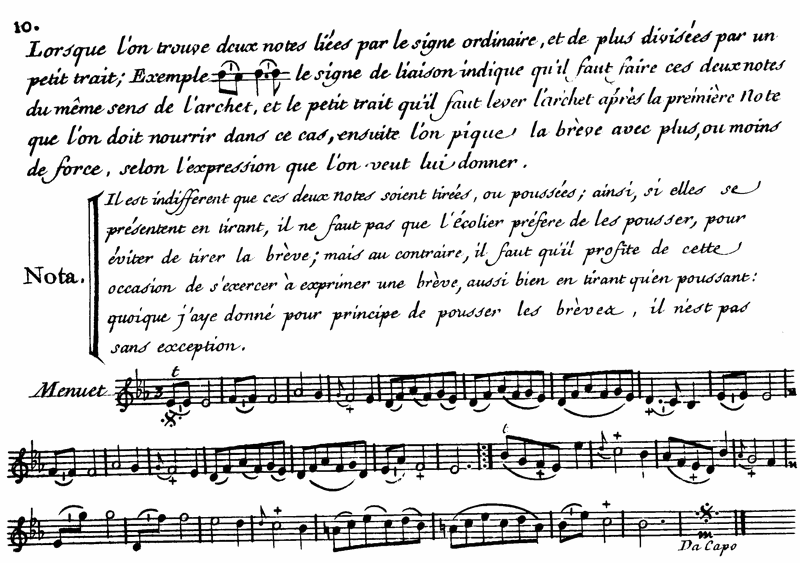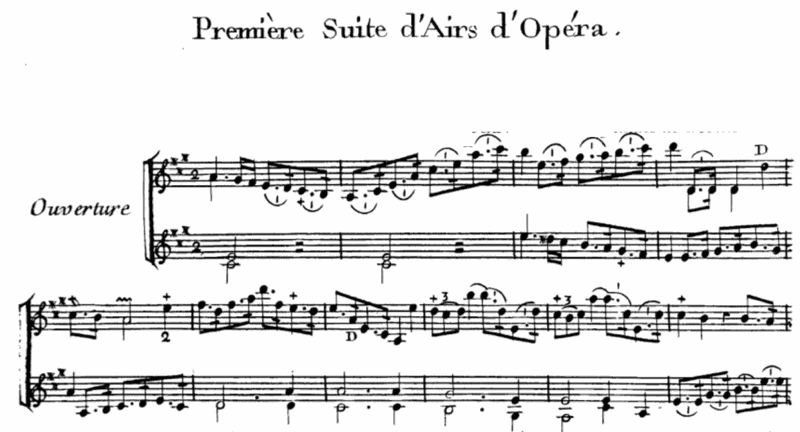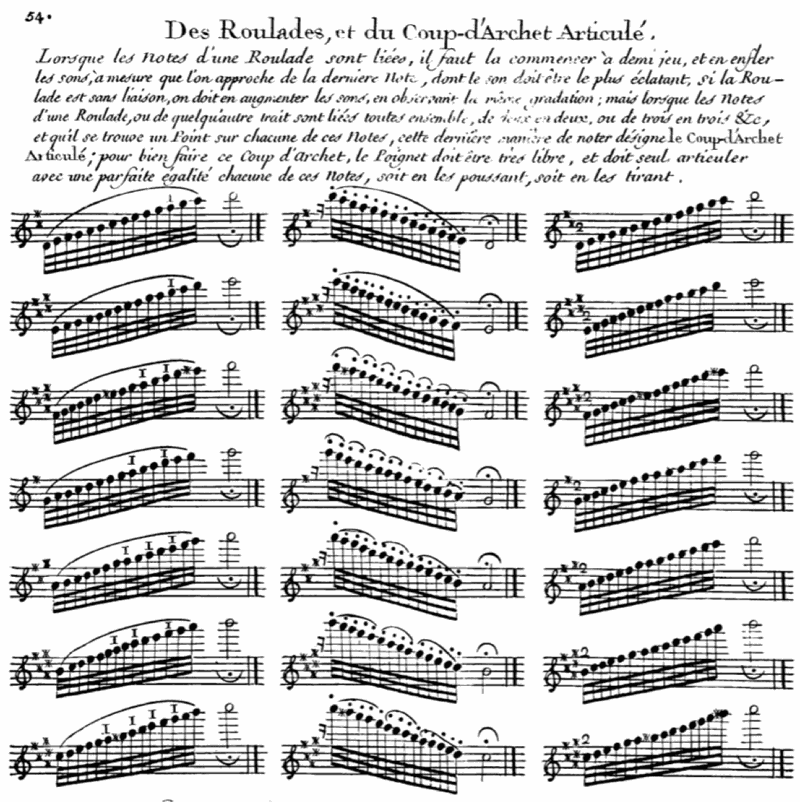A Timeline history of the Violin Bow - from c. 1600 - 1800
... the sources in detail ...
Joseph-Barnabé Saint-Sevin dit L'Abbé le Fils (1727–1803)
Principes du Violon (Paris, 1761)
L'Abbé le Fils was a composer and violinist. As a child prodigy he was noticed by Leclair, with whom he studied from 1740 to 1742. He then joined the Paris Opera Orchestra, with whom he played for twenty years - and was then apparently denied his pension, because he was too young. Plus ça change!!!
His treatise Principes du violon pour apprendre le doigté de cet instrument, et les differens agrémens dont il est susceptible (Paris, 1761), is one of the most significant of the mid 18th century, taking its place alongside Geminiani and Leopold Mozart. Unusually, L'Abbé le Fils jumps straight into the violinistic matters. After a single paragraph on holding the violin, he writes:
His treatise Principes du violon pour apprendre le doigté de cet instrument, et les differens agrémens dont il est susceptible (Paris, 1761), is one of the most significant of the mid 18th century, taking its place alongside Geminiani and Leopold Mozart. Unusually, L'Abbé le Fils jumps straight into the violinistic matters. After a single paragraph on holding the violin, he writes:
On the Manner of Holding the Bow:
The end of the little finger should be placed on the part of the bow fastened to the frog; the index-finger should be placed in such a way that the bow is in contact with the second joint of this finger, which, in order to gain greater power, must be slightly separated from the others. The thumb should be opposite the middle finger and must take the full weight of the bow. When placing the bow on the strings, the stick should not be perpendicularly above the hair, but must be inclined slightly towards the fingerboard.Observations on the bow:
The bow should be held firmly but without stiffening the fingers; on the contrary, all their joints should be very free; by observing this, the fingers will instinctively make imperceptible movements which will contribute considerably to the beauty of the sound: the Wrist must also be very free; the bow must be drawn straight, and always directed over the sound holes of the violin. The forearm should follow the wrist in all the movements. The arm as a whole should only be used when one employs the bow from one end to the other. The elbow should always be separated (detached) from the body. One can call the bow the soul of the instrument which it touches, because it serves to give the expression to the tones, to spin them out, to swell them and to diminish them. To spin out a tone, means to sustain it for a certain duration with the same degree of force. For swelling and diminishing the same sound, it is necessary to start quietly, swell by degrees until it reaches the summit [éclate pleinement], and then soften the same by degrees, such that it finishes imperceptibly.
After showing the open strings, he jumps straight into the Leçons, which simultaneously demonstrate L'Abbé's French style, and the relaxing of the Lullian bowing principles. Here are three Leçons which show inégalité, and Muffat's craquer stroke (t and p meaning down and up, L and b meaning long and short):

As we turn the page, we see that while the desire to play the quavers "the right way round" remains, the necessity of having a down-bow on the barline is longer present - he's even happy to end the first Menuet with an up-bow!;

On page 10, L'Abbé le Fils presents the first example I have seen of 'hooked' bowing -


As we turn the page, we see that while the desire to play the quavers "the right way round" remains, the necessity of having a down-bow on the barline is longer present - he's even happy to end the first Menuet with an up-bow!;

On page 10, L'Abbé le Fils presents the first example I have seen of 'hooked' bowing -

When one finds two notes tied with the ordinary sign, and also separated by a little stroke [see example], the slur indicates that the two notes should be taken in the same bow, and the little stroke that the bow should be lifted after the first note, which in this case should be played with a full tone; then the short note can be played with more or less force depending on the expression one wishes to give it.
Note: It makes no difference if these two notes are played with a down- or an up-bow; thus, if they come on a down bow, the student should not attempt to play them with an up bow in order to avoid a down bow on the short note; but he should, on the contrary, take advantage of this opportunity to practise expression on a short note as often with a down bow as with an up bow; although I have said that in principle one should play short notes with an up bow, there are exceptions.
Note: It makes no difference if these two notes are played with a down- or an up-bow; thus, if they come on a down bow, the student should not attempt to play them with an up bow in order to avoid a down bow on the short note; but he should, on the contrary, take advantage of this opportunity to practise expression on a short note as often with a down bow as with an up bow; although I have said that in principle one should play short notes with an up bow, there are exceptions.
Eight pages later we see this bowing being used in one of his transcriptions for two violins of Airs from the Opera; -


It is worth noting that this is a new idea - in direct contradiction to, for example, Leopold Mozart, who in Chapter 1, Section 3, Paragraph 10 of his Versuch says of such dotted rhythm;


In quick pieces the bow is lifted at each dot: therefore each note is separated from the other and performed in a springing style
.. and of course, one must note that this "hooked bowing" is regarded by L'Abbé as the exception. As he writes, "I have said in principle one should play short notes with an up bow...". By the time the French conservatoire style is established, such hooked bowing is a 'norm' - but it's debatable whether or not we commonly see it before the rise of the Tourte-style bow. In Bailleux, 1798, for example, separate bows for such a figure are still advised. (It's perhaps worth pointing out here, that Löhlein's example of 'hooked' bowing is, pace Stowell, a different category).
The only other specifics about bowing appear later, in the more advanced section, on Page 54. Here he writes about Roulades and up- and down- bow staccato - Coup d'Archet Articulé:
"When the notes of a roulade are slurred, one should begin playing it at half strength and swell the tone as one approaches the last note, which must have the brightest tone; if the roulade is not slurred, its tone must be increased, observing the same gradation; but when the notes of a roulade or some other brilliant passage are all slurred together in twos, threes etc. and there is a dot on each of these notes, this latter manner of notation indicates the coup d’archet articulé; in order to perform this bow stroke well the wrist should be very free and it alone should articulate every note perfectly equally be they up or down
